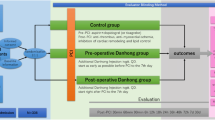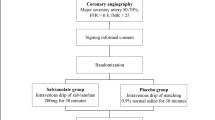Abstract
Objective
To explore the effectiveness of Danhong Injection (丹红注射液) on improving microcirculatory injury after percutaneous coronary intervention (PCI) in patients with coronary heart disease (CHD).
Methods
A randomized controlled trial was conducted and 90 patients were enrolled. A random sequence was generated using statistical analysis software. Patients with microcirculatory injuries after PCI were randomly divided into 3 groups for treatment (30 subjects in each group): Danhong Injection group: after PCI, Danghong Injections were given with intravenous administration with 40 mL twice a day for a week; statins intensive group: after PCI, atorvastatin calcium tablets were given oral medication with 80 mg once, and then atorvastatin 40 mg daily for 1 week; the control group: after PCI, atorvastatin calcium tablets were given oral medication with 10–20 mg daily for 1 week. The index of microcirculation resistance (IMR) was used to assess microcirculatory injury during PCI. The IMR of the target vessel was reexamined after 1 week of drug treatment.
Results
After one week’s drug treatment, IMR was significantly decreased in both statins intensive group and Danhong Injection group compared with the control group (P<0.01), but no difference was found between statins intensive group and Danhong injection group (14.03 ± 2.54 vs. 16.03 ± 5.72 U, P=0.080).
Conclusions
The efficacy of Danhong Injection is non-inferior to statin. Early use of Danhong Injection after PCI can effectively improve coronary microcirculation injury after PCI.
Similar content being viewed by others
References
Kumar J, O’Connor CT, Kumar R, Arnous SK, Kiernan TJ. Coronary no-reflow in the modern era: a review of advances in diagnostic techniques and contemporary management. Expert Rev Cardiovasc Ther 2019;17:605–623.
Laurent B, Omar AM, Gilles L, Julien M, Caroline BB, Alexis J, et al. Incidence and predictors of microvascular dysfunction assessed by the index of microcirculatory resistance following primary PCI for ST elevation myocardial infarction. Int J Cardiol 2011;146:465–467.
Gibson CM, Cannon CP, Murphy SA, Ryan KA, Mesley R, Marble SJ, et al. Relationship of TIMI myocardial perfusion grade to mortality after administration of thrombolytic drugs. Circulation 2000;101:125–130.
Lee BK, Yong AC, Fearon WF, Lim HS, Nguyen PK, Yeung AC, et al. Invasive evaluation of chest pain in patients with angiographically normal coronary arteries. Circulation 2013;128:A19113.
Nishi T, Murai T, Ciccarelli G, Shah SV, Kobayashi Y, Derimay F, Waseda K, et al. Prognostic value of coronary microvascular function measured immediately after percutaneous coronary intervention in stable coronary artery disease: An international multicenter study. Circ Cardiovasc Interv 2019;12:e007889.
Rahman H, Ryan M, Lumley M, Modi B, McConkey H, Ellis H, et al. Coronary microvascular dysfunction is associated with myocardial ischemia and abnormal coronary perfusion during exercise. Circulation 2019;140:1805–1816.
Fineschi M, Bravi A, Gori T. The “slow coronary flow” phenomenon: evidence of preserved coronary flow reserve despite increased resting microvascular resistances. Int J Cardiol 2008;127:358–361.
Fearon WF, Balsam LB, Farouque HM, Caffarelli AD, Robbins RC, Fitzgerald PJ, et al. Novel index for invasively assessing the coronary microcirculation. Circulation 2003;107:3129–3132.
Qian J, Zhao XP, Wang WT, Zhang S, Hong Z, Chen X, et al. Transcriptomic study reveals recovery of impaired astrocytes contribute to neuroprotective effects of Danhong injection against cerebral ischemia/reperfusion-induced injury. Front Pharmacol 2018;9:250.
Ito N, Nanto S, Doi Y, Sawano H, Masuda D, Yamashita S, et al. High index of microcirculatory resistance level after successful primary percutaneous coronary intervention can be improved by intracoronary administration of nicorandil. Circ J 2010;74:909–915.
Melikian N, Vercauteren S, Fearon WF, Cuisset T, Maccarthy PA, Davidavicius G, et al. Quantitative assessment of coronary microvascular function in patients with and without epicardial atherosclerosis. Euro Intervention 2010;5:939–945.
Wang W, Wang YP, Sun WK, XU YM, Xuan LJ. Effects of magnesium lithospermate B on aggregation and 5-HT release in rabbit washed platelets. Acta Pharmacol Sin 2000;21:859–863.
Xue L, Wu Z, Ji XP, Gao XQ, Guo YH. Effect and mechanism of salvianolic acid B on the myocardial ischemia-reperfusion injury in rats. Asian Pac J Trop Med 2014;7:280–284.
Zang BX, Jing M, Si N, Zhang Y, Wu W, Piao YZ. Antagonistic effect of hydroxysafflor yellow a on the platelet activating factor receptor. Acta Pharmaceut Sin 2002;37:696–699.
Wei G, Yin Y, Duan JL, Guo C, Zhu YR, Wang YH, et al. Hydroxysafflor yellow A promotes neovascularization and cardiac function recovery through HO-1/VEGF-A/SDF-1 α cascade. Biomed Pharmacother 2017;88:409–420.
Ma XJ, Yin SJ, Jin JC, Wu CF, Huang Y, Shi DZ, et al. Synergistic protection of Danhong Injection and ischemic postconditioning on myocardial reperfusion injury in minipigs. Chin J Integr Med 2010;16:531–536.
Zhang YY, Zhou HF, Yang JH, He Y, Chen XQ, Katsuyoshi N, et al. Effects of Danhong Injection and its main components on anticoagulation and fibrinolysis in cultured vein endothelial cells. Chin J Integr Med 2016;22:276–283.
Afilalo J, Majdan AA, Eisenberg MJ. Intensive statin therapy in acute coronary syndromes and stable coronary heart disease: a comparative meta-analysis of randomised controlled trials. Heart 2007;93:914–921.
Chen RX, Xiao Y, Chen MH, He JY, Huang MT, Hong XT, et al. A traditional Chinese medicine therapy for coronary heart disease after percutaneous coronary intervention: a meta-analysis of randomized, double-blind, placebo-controlled trials. Biosci Rep 2018;38:BSR20180973.
Lyu M, Yan CL, Liu HX, Wang TY, Shi XH, Liu JP, et al. Network pharmacology exploration reveals endothelial inflammation as a common mechanism for stroke and coronary artery disease treatment of Danhong Injection. Sci Rep 2017;7:15427.
Author information
Authors and Affiliations
Contributions
Liu QR, Liu HX and Wu YJ designed research; Liu QR, Xing WL and Zhou Q analyzed data; Liu QR, Xing WL, Liu HX, Zhang HL, Song GY and Wu YJ performed research; Liu QR and Zhang HT wrote the paper.
Corresponding author
Additional information
Conflict of Interest
The author declares no conflicts of interest.
Supported by Capital Health Development Research Project (No. 2014-2-4032)
Rights and permissions
About this article
Cite this article
Liu, Qr., Liu, Hx., Xing, Wl. et al. Effect of Danhong Injection (丹红注射液) on Improving Coronary Microcirculation Injury after Percutaneous Coronary Intervention. Chin. J. Integr. Med. 27, 455–460 (2021). https://doi.org/10.1007/s11655-021-2853-4
Accepted:
Published:
Issue Date:
DOI: https://doi.org/10.1007/s11655-021-2853-4




